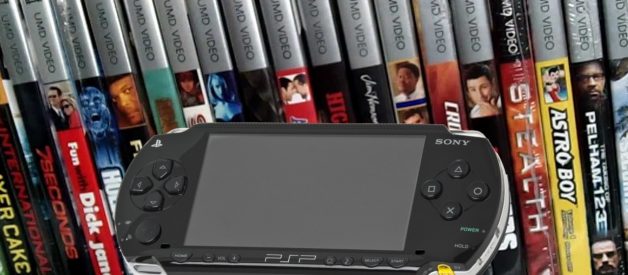
The 1990s through to the early 2000s was a frantic time in the development of portable media devices, from CD and cassette players to phones, MP3 players, and video game consoles. Movies, however, were relatively late to the party, limited by large file sizes and the bulkiness of laptops and portable DVD players at the time.
Various attempts were made to bring affordable portable video devices to the market, including the VideoNow unit that played kids TV shows in black-and-white. In 2004 Nintendo entered the market in collaboration with 4Kids Entertainment in the form of GBA Video: cartridges that stored episodes from children?s shows and even a few movies for playback on the Game Boy Advance. The quality of the footage wasn?t great, however, with GBA Video playing in 240×160 resolution at a chugging frame rate. Sales were also poor.
Nevertheless, GBA Video did prove that distributors could use the existing install-base of portable game consoles to sell more than just games. Console manufacturers were beginning to realise this too ? Nokia?s N-Gage was a phone/game console cross-over that could also play video and music, while Nintendo?s DS line of devices were marketed as digital planners and cognitive training tools as well as gaming units.
Sony had experience in the multimedia game with the inlusion of DVD playback capabilities in their PlayStation 2 home console, giving it a big edge over competitors like Sega?s Dreamcast. Following the success of the PS2, it was perhaps only natural that Sony would try to replicate this multimedia magic when they entered the portable console space with their PlayStation Portable (PSP), launched in December 2004 in Japan, March 2005 in North America, and September 2005 in Europe.
Of course, a properly portable device was never going to be big enough to support DVDs, so they had to develop a brand new format that was up to the task. Sony?s solution? The Universal Media Disc, or UMD.
UMD is a proprietary miniature optical disc format that can hold 1.8GB of data. It came encased in a plastic shield to protect it from knocks and scratches, and was only ever used for the PSP. When the PSP was revealed during Sony?s press conference at E3 2004, Kaz Hirai, President and CEO of Sony Computer Entertainment America, stressed that Sony saw this console as a multimedia platform, and that the UMD would support full-length films, branded as UMD Video, as well as games.
Trailers for Spider-Man 2 and Final Fantasy XII: Advent Children were shown playing on a PSP unit, and when the US launch date came, the first 1 million PSP Value Packs (priced at $250) contained a Spider-Man 2 UMD. Masa Chatani, Chief Technology Officer of Sony Computer Entertainment, expressed great enthusiasm in media interviews, saying: ?In the U.S. We have already met with the major studios. They pretty much love the PSP and the quality of the UMD.?
Sony announced an initial UMD price range of $19.95 to $28.95, with the lower range applying to movies previously released on DVD, and the higher range for new films launching on UMD and DVD at the same time. Each UMD would contain the full-length movie encoded in 720×480, the same as an average DVD, but this would be scaled down to 480×272 when playing on the PSP?s screen. Due to storage constraints (the average DVD could hold 4.7GB of data to the UMD?s 1.8GB), special features such as deleted scenes and ?making of? reels would often be removed.
 A Universal Media Disc in its caddy.
A Universal Media Disc in its caddy.
Despite these limitations, early signs were encouraging for UMD Video. Within a few months the format could boast 70 available titles in the US and over 500,000 overall sales. Available titles grew to over 200 within half a year, encouraged by the PSP?s strong sales. Two movies released by Sony Pictures passed 100,000 sales within a month. The first DVD to pass that mark, Air Force One, took 9 months. Sony UK chief Ray Maguire said in October 2006 that Sony was ?pretty pleased with UMD,? commenting that it had ?a fantastic attachment rate?.
It wasn?t long before cracks began to show, however: and that isn?t just a reference to the UMD casing?s tendency to break, rendering the disc unusable. Film studios and retailers started to express concerns about the format?s long-term sales performance. In the US, Wal-Mart and Target had already begun pulling away from UMD Video in early 2006, while anonymous executives from Universal Studios Home Entertainment told the Hollywood Reporter in March 2006: ?It?s awful. Sales are near zilch. It?s another Sony bomb, like Blu-ray.? An executive from Paramount similarly said of UMD: ?No one?s even breaking even on them.? In response to such criticism, Benjamin Feingold of Sony Pictures Home Entertainment blamed the disappointing sales on people ripping DVDs and then playing them on PSP via the memory card slot.
The company continued to show public optimism about the format even as some major studios and retailers pulled the plug entirely. PSP senior marketing manager John Koller told Pocket Gamer in June 2007 that: ?The future of movies on UMD is great. We saw a 35 per cent growth year-on-year from 2005 to 2006, which clearly demonstrates a growing interest.? Significantly, sales in Japan had jumped tenfold following major price-cuts. Koller said this was also the result of movie distributors ?calibrating? their UMD offerings to target the PSP?s primary user base: males under the age of 25. This helps explain the composition of UMD Video?s library, which is heavily weighted towards action, sci-fi, and comedy films.
Despite the positive signals coming from Sony, in 2007 things started to get quieter on the UMD Video front. In part this was down to the industry?s growing focus on digital distribution ? in 2009 Sony launched the digital-only PSP Go model. Nevertheless, the UMD Video library grew steadily. The most complete list online counts over 650 video discs, but the list is missing many known entries, and the real figure may be more in the region of 800?1,000.
When compared to the 36 cartridges released for GBA Video, UMD Video looks like a runaway success. All three Matrix films and all eight Harry Potter films were released as UMDs, along with numerous Batman movies, Academy Award-winning masterpieces like Crouching Tiger, Hidden Dragon, and episodes of popular TV shows such as Doctor Who.
Sony Pictures released its last UMD Video discs in 2010, and the final third-party release came from Warner Home Video in 2011. And with that, so ended the last major attempt at a game console-specific proprietary video format. With so many easy ways to watch video content in our hands today, it is very unlikely that we will see anything like it again.
These discs haven?t yet become a major focus in the collecting world, but there are reasons to believe that might change. In 2018 UMD Video entered into the top-10 most-contributed formats on Filmogs. And as the noughties become more distant and the PSP becomes a ?retro? console, I suspect UMD Video will take its proper place as both a nostalgic oddity and a genuinely intriguing episode in media history.


